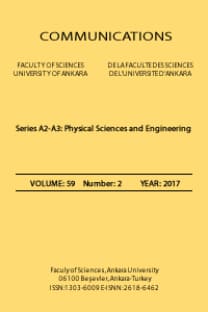A new astronomical parameter from remote sensing data: Astronomical clearness index (ACI)
Astronomical clearness index, astronomy, cloud mask and types, Eastern Anatolia Observatory, remote sensing
___
McInnes, B., Walker, M.F., Astronomical site testing in the Canary Islands, Publications of the Astronomical Society of the Pacific, 86 (512) (1974), 529-544. https://doi.org/10.1086/129641Calisse, P.G., Ashley, M.C.B., Burton, M.G., Phillips, M.A., Storey, J.W.V., Radford, S.J.E., Peterson, J.B., Submillimeter site testing at Dome C, Antarctica, Publications of the Astronomical Society of Australia, 21 (3) (2004), 256-263. https://doi.org/10.1071/AS03018
Schöck, M., Els, S., Riddle, R., Skidmore, W., Travouillon, T., Blum, R., Bustos, E., Chanan, G., Djorgovski, S. G., Gillett, P., Gregory, B., Nelson, J., Otárola, A., Seguel, J., Vasquez, J., Walker, A., Walker, D., Wang, L., Thirty meter telescope site testing I: overview, Publications of the Astronomical Society of the Pacific, 121 (878) (2009), 384- 395. https://doi.org/10.1086/599287
Vernin, J., Muñoz-Tuñón, C., Sarazin, M., Vazquez Ramió, H., Varela, A.M., Trinquet, H., Delgado, J.M., Jiménez Fuensalida, J., Reyes, M., Benhida, A., Benkhaldoun, Z., Garcia Lambas, D., Hach, Y., Lazrek, M., Lombardi, G., Navarrete, J., Recabarren, P., Renzi, V., Sabil, M., Vrech, R., European extremely large telescope site characterization I: overview, Publications of the Astronomical Society of the Pacific, 123 (909) (2011), 1334-1346. https://doi.org/10.1086/662995
Hidayat, T., Mahasena, P., Dermawan, B., Hadi, T. W., Premadi, P. W., Herdiwijaya, D., Clear sky fraction above Indonesia: an analysis for astronomical site selection, Monthly Notices of the Royal Astronomical Society, 427 (3) (2012), 1903-1917. https://doi.org/10.1111/j.1365-2966.2012.22000.x
Koc-San, D., San, B. T., Bakış, V., Helvacı, M., Eker, Z., Multi-Criteria Decision Analysis integrated with GIS and remote sensing for astronomical observatory site selection in Antalya province, Turkey, Advances in Space Research, 52 (1) (2013), 39- 51. https://doi.org/10.1016/j.asr.2013.03.001
Aksaker, N., Yerli, S. K., Erdoğan, M. A., Erdi, E., Kaba, K., Ak, T., Aslan, Z., Bakış, V., Demircan, O., Evren, S., Keskin, V., Küçük, İ., Özdemir, T., Özışık, T., Selam, S. O., Astronomical site selection for Turkey using GIS techniques, Experimental Astronomy, 39 (3) (2015), 547-566. https://doi.org/10.1007/s10686-015-9458-x
Falvey, M., Rojo, P.M., Application of a regional model to astronomical site testing in western Antarctica, Theoretical and Applied Climatology, 125 (3-4) (2016), 841-862. https://doi.org/10.1007/s00704-016-1794-x
Hellemeier, J.A., Yang, R., Sarazin, M., Hickson, P., Weather at selected astronomical sites - an overview of five atmospheric parameters, Monthly Notices of the Royal Astronomical Society, 482 (4) (2019), 4941-4950. https://doi.org/10.1093/mnras/sty2982
Aksaker, N., Yerli, S.K., Erdoğan, M.A., Kurt, Z., Kaba, K., Bayazit, M., Yeşilyaprak, C., Global site selection for astronomy, Monthly Notices of the Royal Astronomical Society, 493 (1) (2020), 1204-1216. https://doi.org/10.1093/mnras/staa201
Badescu, V., Dumitrescu, A., CMSAF products Cloud Fraction Coverage and Cloud Type used for solar global irradiance estimation, Meteorology and Atmospheric Physics, 128 (4) (2016), 525–535. https://doi.org/10.1007/s00703-015-0424-y
Chernokulsky, A., Esau, I., Cloud cover and cloud types in the Eurasian Arctic in 1936- 2012, International Journal of Climatology, 39 (15) (2019), 5771-5790. https://doi.org/10.1002/joc.6187
Kotarba, A.Z., Chacewicz, S., Żmudzka, E., Night sky photometry over Warsaw (Poland) evaluated simultaneously with surface-based and satellite-based cloud observations, Journal of Quantitative Spectroscopy and Radiative Transfer, 235 (2019), 95-107. https://doi.org/10.1016/j.jqsrt.2019.06.024
Toy S, Kantor N. Evaluation of human thermal comfort ranges in urban climate of winter cities on the example of Erzurum city. Environmental Science and Pollution Research, 24 (2) (2017), 1811-1820. https://doi.org/10.1007/s11356-016-7902-8
Derrien, M., Le Gléau, H., MSG/SEVIRI cloud mask and type from SAFNWC, International Journal of Remote Sensing, 26 (21) (2005), 4707-4732. https://doi.org/10.1080/01431160500166128
Yüzlükoğlu F., Erzurum ve çevresinin astronomi gözlemleri açısından atmosferik özellikleri. M.Sc. Thesis, Atatürk University, Erzurum, Turkey, 2017.
Marks, R. D., Astronomical seeing from the summits of the Antarctic plateau, Astronomy & Astrophysics, 385 (1) (2002), 328-336. https://doi.org/10.1051/0004-6361:20020132
Seghouani, N., Boer, M., & Mimouni, J., National Aures Observatory: A new multimessenger facility, Journal of Physics: Conference Series, 1269 (1) (2019), 012001.
- ISSN: 1303-6009
- Yayın Aralığı: Yılda 2 Sayı
- Başlangıç: 2019
- Yayıncı: Ankara Üniversitesi
Impurity effects on activation energy, structure and physical properties of Ybco superconductor
ENHANCED BOOST CONVERTER WITH GaN BASED POWER SWITCHES AND SWITCHED-CAPACITOR
DETERMINING THE MOST RELEVANT INPUT PARAMETER SET BY USING EXTREME LEARNING MACHINE
A new astronomical parameter from remote sensing data: Astronomical clearness index (ACI)
Kazım KABA, Cahit YEŞİLYAPRAK, Onur ŞATIR
Analysis of Bragg curve parameters and lateral straggle for proton and carbon beams
Fatih EKİNCİ, Gazi Erkan BOSTANCI, Özlem DAĞLI, Mehmet Serdar GÜZEL
